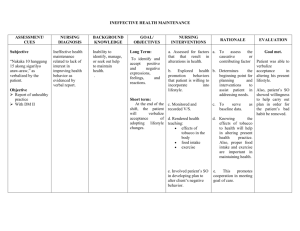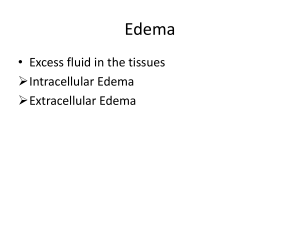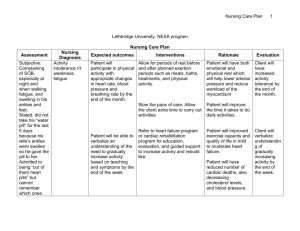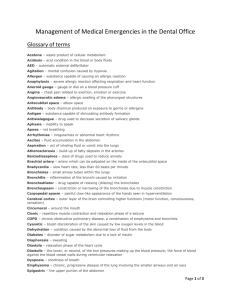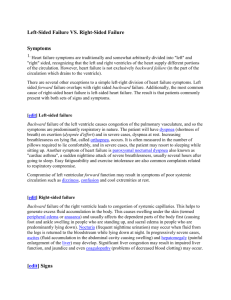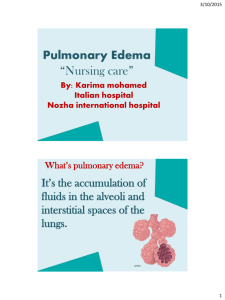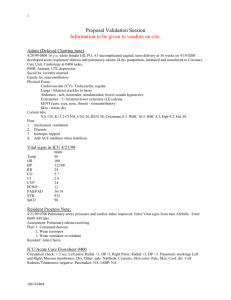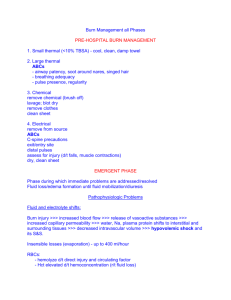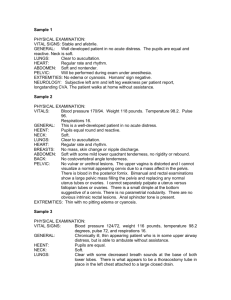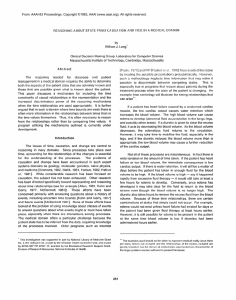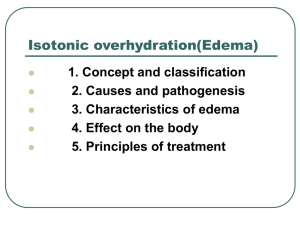3 - INAYA Medical College
advertisement
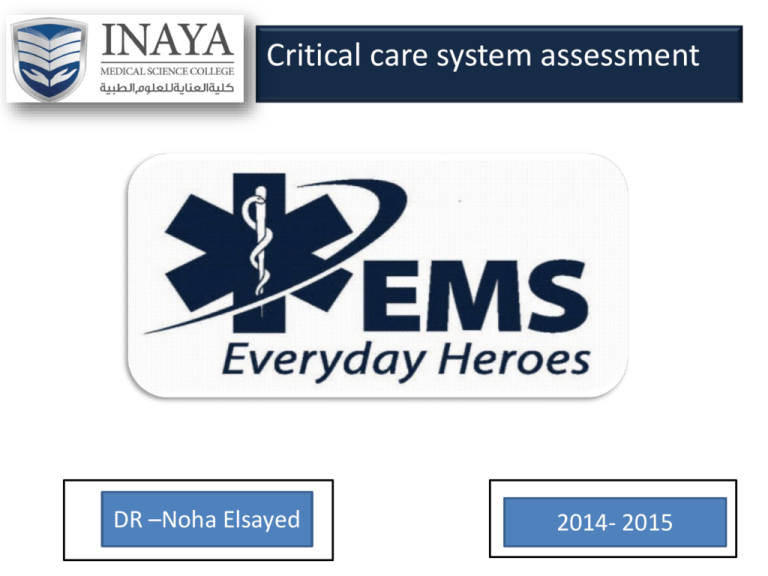
Critical care system assessment DR –Noha Elsayed 2014- 2015 Critical care system assessment Is typically system based Example: Subarachnoid hemorrhage …..Required detailed neurologic exam at least hourly Obtained data must be individualized to patients & their conditions Generalization of assessment finding may lead to CCTP astray & impact patient care. For example: New born with cyanosis of lips should illicit a different response from the clinician than an adult with the same. Subjective information from the patient & family (Chief complaint, Review of systems, History of past & present illness) is more important than objective information obtained during an actual exam. These questions should guide the provider to ask other questions or to examine objective data to qualify the information. For example: While being placed on a stretcher …. A patient asks for four pillows …. An alert CCTP will inquire more about the need for the pillows May be Orthopenia …. Shortness of breath (Left ventricular dysfunction) The CCTP must then ask …. How long have you been sleeping on four pillows in attempt to a certain worsening of the condition Critical care system assessment A. B. C. D. E. F. G. H. General appearance Cardiovascular assessment Respiratory assessment Neurologic assessment Gastrointestinal assessment Genitourinary assessment Musculoskeletal assessment Psychosocial & Emotional assessment 1. A. B. C. General appearance: Apparent age relative to chronological age Level of consciousness (LOC) Skin findings Presence & degree of edema Skin lesions State of finger tips & nail beds Skin temperature Cool …. Indicates vasoconstriction Warm or hot …. Fever May be wet or dry Skin Turgor …. This is an indicator of fluid status …. May be rapid or sluggish ( Should be assessed over the sternum or forehead) May be misleading especially in elderly people or people with friable skin D. Presence or absence of gross deformity E. Stature, Posture, Gait (If the patient is ambulatory) F. Position of comfort (Such as: Tripod position …. Significant cardiovascular or respiratory diseases) Cardiovascular assessment: A. Inspection B. Auscultation C. Palpation Not included with us D. Percussion Inspection I. II. III. IV. V. VI. General appearance Skin color Edema Interpretation of ECG rhythm Assessing pulse (Peripheral pulse) how many beats are perfused 2. Cardiovascular assessment: A. Inspection I. II. General appearance (Cachetic, Obese) Skin color (Cyanosis, Pallor, jaundice) Cyanosis It indicates Hypoxia (Acute oxygen insufficiency) When cyanosis combines with clubbing (Angle between the nail & nail bed > 160 ) …. This may indicate long term hypoxia associated with chronic obstructive lung disease It may be Central or Peripheral III. Edema (Location & Severity) Pedal edema should be evaluated by pressing on the skin behind the medial malleolous, over the shin of tibia and over the dorsum of each foot with the thumb and index finger for at least 5 seconds A slight indentation that disappears in a short time …. Trace edema Deep pitting that doesn’t disappear readily ….Grade +3 or +4 Location of edema & usual position of the patient are used to differentiate between dependent & non-dependent edema Example: Ambulatory & seated patients …. Edema develops in lower extremities Where as, Patients confined to bed …. More edema in sacral area IV. Interpretation of ECG rhythm is essential You must have a copy of 12 lead ECG accompanying the transfer record The answer of these questions must be present: 1. What is the underlying or baseline rhythm?? 2. What is the usual monitoring lead & morphology?? 3. What arrhythmia has the patient experienced?? 4. What arrhythmia has the patient experienced?? 5. What effects did the arrhythmia have on the patients & was any treatment used?? 6. Has the patient ever required defibrillation or cardio version?? 7. If the patient has a pacemaker &/or implanted cardio defibrillator?? V. Assessing pulse (Peripheral pulse): For example: 1. Carotid 5. Popilteal 2. Radial 6. Post. Tibia 3. Brachial 7. Dorsalis pedis 4. Femoral Pulse should be assessed bilaterally for presence , strength, pattern N.B. Carotid should be palpitated one side at a time & without a massaging type action …. This may cause vagal response & loss of consciousness or embolization of carotid plaque deposits VI. You must know how many beats are perfused by comparing the rate on ECG monitor with the heart rate on a pulse oximetry display Take care: Avoid using invasive monitoring equipment because a skilled health care professional can obtain same data by using assessment skills For example:-central venous pressure or pressure in the right atrium ……which is indicator of fluid status Can be obtained by using an invasive triple lumen catheter or just by observing for jugular venous distension by hepato jugular reflex (Applying mid abdominal pressure while observing for jugular venous distension …. If noted → Means +ve = Pressure on abdomen displaces fluid from an engorged liver indicating volume overload) Auscultation: I. Heart sounds II. Auscultation over the carotid ,renal and femoral arteries III. Blood pressure B. Auscultation: I. Heart sounds Requires years of practice to become proficient Auscultated areas: Aortic, Pulmonic, Tricuspid, Mitral valve …. With diaphragm & bell of stethoscope Heart sound should be evaluated for Pattern, Intensity, Quality, Pitch & Murmur N.B. Systolic murmur appearing after an inferior myocardial infarction is much more significant than diastolic murmur II. Auscultation over the carotid ,renal and femoral arteries Detection of bruits and or loud harsh sounds indicates blood flow through a narrowed artery III. Blood pressure Normal B.P in critically ill patients, is defined by the individual patient ,not text book SBP =90 mmhg may be normal in 20 years old but may be abnormal in patients with a recent myocardial infarction and history of hypertension. Trends in B.P over time should be noted especially in response to cardiogenic medications & interventions. Typically B.P is re-assessed every 5 min. in acutely ill critical care patients & up to 15 min. in stable critical care patients. When titrating pressors, 5 min interval should be the maximal safe interval for B.P management. Orthostatic B.P was previously used in the critical care to assess the need for fluid resuscitation, but nowadays is limited as it requires sitting & standing measurements of B.P (Impractical) Passive leg raising (PLR): Is used to assess fluid responsiveness in patients with suspected volume depletion Is performed with patients in a supine position by raising both of patient’s legs to 45o angle & B.P assessed again while the patient’s legs are raised within 30 seconds Results in a reversible auto transfusion of some 150 to 300 ml of blood into central circulation ↙ ↘ Improvement in B.P Non improvement Administrate fluid No fluid administration Take care: Remember to make head to toe assessment every 4 hours
